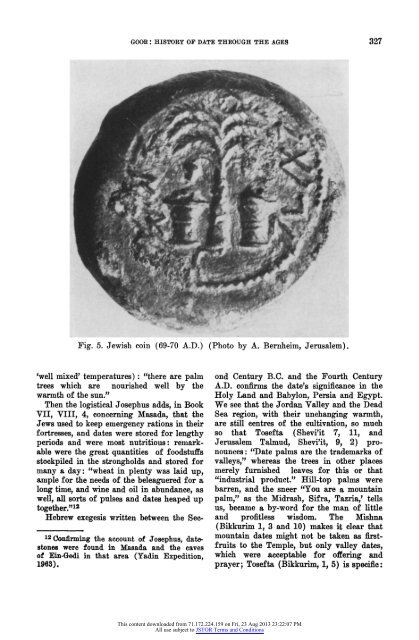The History of the Date through the Ages in the Holy Land
The History of the Date through the Ages in the Holy Land
The History of the Date through the Ages in the Holy Land
Create successful ePaper yourself
Turn your PDF publications into a flip-book with our unique Google optimized e-Paper software.
GOOR: HISTORY OF DATE THROUGH THE AGES 327<br />
Fig. 5. Jewish co<strong>in</strong> (69-70 A.D.) (Photo by A. Bernheim, Jerusalem).<br />
'well mixed' temperatures): "<strong>the</strong>re are palm<br />
trees which are nourished well by <strong>the</strong><br />
warmth <strong>of</strong> '<strong>the</strong> sun."<br />
<strong>The</strong>n <strong>the</strong> logistical Josephus adds, <strong>in</strong> Book<br />
VII, VIII, 4, concern<strong>in</strong>g Masada, that <strong>the</strong><br />
Jews used to keep emergency rations <strong>in</strong> <strong>the</strong>ir<br />
fortresses, and dates were stored for lengthy<br />
periods and were most nutritious: remarkable<br />
were <strong>the</strong> great quantities <strong>of</strong> foodstuffs<br />
stockpiled <strong>in</strong> <strong>the</strong> strongholds and stored for<br />
many a day: "wheat <strong>in</strong> plenty was laid up,<br />
ample for <strong>the</strong> needs <strong>of</strong> <strong>the</strong> beleaguered for a<br />
long time, and w<strong>in</strong>e and oil <strong>in</strong> abundance, as<br />
well, all sorts <strong>of</strong> pulses and dates heaped up<br />
toge<strong>the</strong>r."12<br />
Hebrew exegesis written between <strong>the</strong> Sec-<br />
12 tonfirm<strong>in</strong>g <strong>the</strong> account <strong>of</strong> Josephus, datestones<br />
were found <strong>in</strong> Masada and <strong>the</strong> eaves<br />
<strong>of</strong> E<strong>in</strong>-Gedi <strong>in</strong> that area (Yad<strong>in</strong> Expedition,<br />
1963).<br />
ond Century B.C. and <strong>the</strong> Fourth Century<br />
A.D. confirms <strong>the</strong> date's significance <strong>in</strong> <strong>the</strong><br />
<strong>Holy</strong> <strong>Land</strong> and Babylon, Persia and Egypt.<br />
We see that <strong>the</strong> Jordan Valley and <strong>the</strong> Dead<br />
Sea region, with <strong>the</strong>ir unchang<strong>in</strong>g warmth,<br />
are still centres <strong>of</strong> <strong>the</strong> cultivation, so much<br />
so that Tosefta (Shevi'it 7, 11, and<br />
Jerusalem Talmud, Shevi'it, 9, 2) pronounces:<br />
"<strong>Date</strong> palms are <strong>the</strong> trademarks <strong>of</strong><br />
valleys," whereas <strong>the</strong> trees <strong>in</strong> o<strong>the</strong>r places<br />
merely furnished leaves for this or that<br />
"<strong>in</strong>dustrial product." Hill-top palms were<br />
barren, and <strong>the</strong> sneer "You are a mounta<strong>in</strong><br />
palm," as <strong>the</strong> Midrash, Sifra, Tazria,' tells<br />
us, became a by-word for <strong>the</strong> man <strong>of</strong> little<br />
and pr<strong>of</strong>itless wisdom. <strong>The</strong> Mishna<br />
(Bikkurim 1, 3 and 10) makes it clear that<br />
mounta<strong>in</strong> dates might not be taken as firstfruits<br />
to <strong>the</strong> Temple, but only valley dates,<br />
which were acceptable for <strong>of</strong>fer<strong>in</strong>g and<br />
prayer; Tosefta (Bikkurim, 1, 5) is specific:<br />
This content downloaded from 71.172.224.159 on Fri, 23 Aug 2013 23:22:07 PM<br />
All use subject to JSTOR Terms and Conditions
















